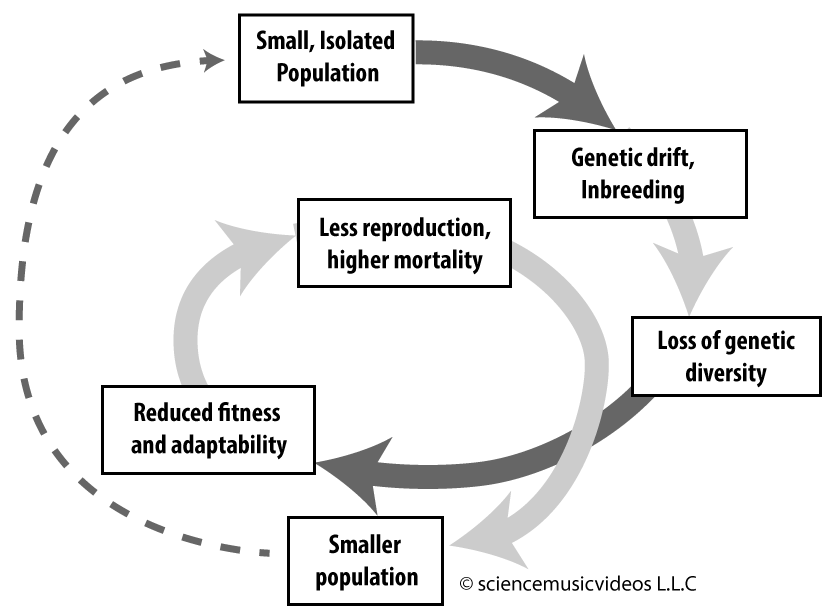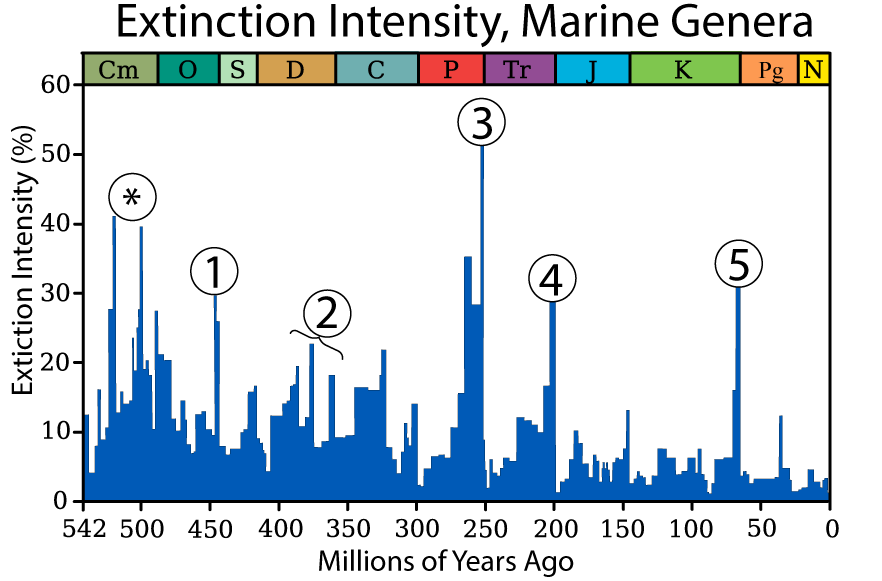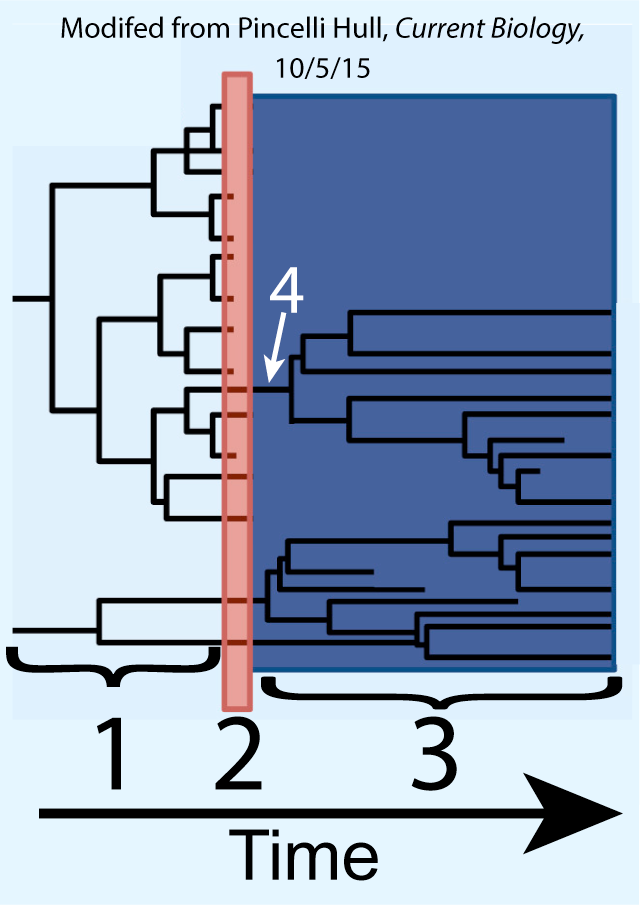Start by watching the video below. Then complete the flashcards and quizzes. For a deeper dive into this material, complete this tutorial in our AP Bio 2.0 Curriculum: Topics 7.10 – 7.12, Part 4: Extinction
1. Watch this video
2. Study this summary
Extinction is the permanent disappearance of a species from Earth. When the last individual of a species dies, that species has become extinct.
Here’s what you need to know about extinction for your AP Bio course.
Extinction has been happening throughout the history of life
- Extinction is a normal and significant part of life’s evolutionary history.
- Over 99% (possibly 99.9%) of all species that have ever lived are now extinct.
The Extinction Vortex
Extinction can occur when a species can no longer survive in its ecological niche. This might be because of a change in the environment, or the arrival of a better-adapted competitor.
The result is that a species enters into an extinction vortex.

- Definition: A positive feedback loop/vicious cycle that accelerates the decline of small, isolated populations towards extinction.
- Process:
- Population decline (triggered by environmental changes, climate shifts, or competitive species).
- Leads to genetic drift and loss of genetic diversity.
- Reduced genetic diversity results in lower fitness and adaptability.
- Further population decline ensues, perpetuating the cycle.
Mass Extinctions

- Defined as rapid, widespread decreases in Earth’s biodiversity.
- Causes: Geological, astronomical, and sometimes biological events.
- The Big Five: Five major extinction events have occurred during the past 600 million years.
- The most recent mass extinction, the Cretaceous Extinction (~65 million years ago), eliminated the dinosaurs.
Extinctions are followed by diversification

- Mass extinctions leave ecological niches vacant, promoting the diversification of surviving species. This occurs through adaptive radiation on the part of surviving species.
- Example: Placental mammals (the group to which humans belong) diversified extensively after the Cretaceous Extinction (which wiped out the dinosaurs)
Human Impact on Extinction
- Humans are driving a potential sixth mass extinction by:
- Habitat destruction and fragmentation.
- Overhunting and overharvesting.
- Introducing invasive species to new ecosystems.
- This decline in biodiversity could rival previous mass extinctions.
3. Master these flashcards
[qdeck bold_text=”false” style=”width: 600px !important; min-height: 450px !important;” qrecord_id=”sciencemusicvideosMeister1961-Extinction Flashcards, APBVP”]
[h]Extinction Flashcards
[i]
[q] What is extinction?
[a] Extinction is the permanent disappearance of a species from Earth, occurring when the last individual of the species dies.
[q] How does adaptive radiation follow mass extinction events?
[a] After a mass extinction, ecological niches become vacant. Surviving species diversify to fill these niches, leading to a burst of new species and increased biodiversity. An example is the diversification of mammals after the Cretaceous extinction that wiped out the dinosaurs.
[q] What is the sixth extinction, and what human activities are causing it?
[a] The sixth extinction refers to the current decline in global biodiversity caused by human activities. These activities include:
- Habitat destruction and fragmentation.
- Overhunting and overharvesting of animals and plants.
- Introduction of invasive species to new environments.
[q] List two things that might cause a species to become extinct.
[a]Causes of extinction could include
- Disruption of a species’ habitat (where a species lives). That can occur through a variety of ecological or geological processes that change the climate or alter the landscape.
- Some ecological disturbance interferes with how a species survives within its ecological niche (its way of making a living). Often, this disturbance involves a new competitor, predator, or parasite.
[q] Describe what happens as a species enters an extinction vortex.
[a]As a species enters an extinction vortex
- Ecological disturbances make it difficult for a species to successfully survive in its habitat and niche. As a result, there’s a decrease in the population size.
- This lowered size leads to genetic drift and decreases genetic variability.
- Decreased variability makes the population less fit and adaptable
- Lowered fitness leads to higher mortality and a lower birth rate.
- Additional disturbances lead to further population decline.
[q]What’s a mass extinction? On a very general level, what causes mass extinctions?
[a]A mass extinction is when many species simultaneously become extinct at a rate that far exceeds the background level of extinction.
The causes of these extinctions are generally geological (massive volcanic eruptions changing the climate, or movements of continents that obliterate coastlines) or astronomical (impacts of comets or asteroids that cause massive devastation on a planetary scale).
[q]
- List the number of mass extinctions that have happened during the past 600 million years, and
- Describe one of these mass extinctions.
[a]Not including the current mass extinction, there have been 5 mass extinctions during the past 600 million years (5 that are well-documented in the fossil record).
- The Cretaceous-Tertiary extinction wiped out the dinosaurs about 65 million years ago).
- “The Great Dying” (the Permian extinction) occurred 250 million years ago
[q]Interpret the graph below.
[a]
The graph shows how biodiversity returns after a mass extinction.
- The amount of biodiversity (number of taxa) before a mass extinction
- Mass extinction
- Biodiversity after the mass extinction
- Rise in biodiversity as each surviving species undergoes adaptive radiation
- A new level of biodiversity after recovery.
[q]Interpret the graph below.
[a]This graph shows how biodiversity returns after a mass extinction.
- The array of species existing before a mass extinction.
- Mass extinction event
- Adaptive radiation of survivors after the mass extinction.
- One of the survivors.
[x][restart]
[/qdeck]
4. Tackle this quiz
[qwiz style=”width: 600px !important;” qrecord_id=”sciencemusicvideosMeister1961-Extinction Quiz, APBVP”]
[h] Understanding Extinction
[i]
[q] Extinction happens when a species can no longer exploit its ecological [hangman]. This might be because of a change in the [hangman], or the arrival of a better-adapted [hangman].
[c]IG5pY2hl[Qq]
[f]IEdyZWF0IQ==[Qq]
[c]IGVudmlyb25tZW50[Qq]
[f]IEV4Y2VsbGVudCE=[Qq]
[c]IGNvbXBldGl0b3I=[Qq]
[f]IENvcnJlY3Qh[Qq]
[q] The positive feedback loop in which ecological disturbance lowers a population’s size to the point where it has less genetic variability and becomes less adaptable, which further lowers the population’s size is known as an [hangman] [hangman].
[c]ZXh0aW5jdGlvbg==[Qq]
[c]IHZvcnRleA==[Qq]
[q multiple_choice=”true”] It’s estimated that _________ of the species that have ever existed are now extinct.
[c]IG92ZXIgbmluZXR5LW 5pbmUgcGVyY2VudA==[Qq]
[f]IE5pY2Ugam9iLiBPdmVyIDk5LjklIG9mIHRoZSBzcGVjaWVzIHRoYXQgaGF2ZSBldmVyIGxpdmVkIGFyZSBub3cgZXh0aW5jdC4=[Qq]
[c]IGhhbGY=[Qq]
[f]IE5vLiBJdCYjODIxNztzIG11Y2ggaGlnaGVyIHRoYW4gdGhhdC4=[Qq]
[c]IG9ubHkgYSBzbWFsbCBwZXJjZW50YWdl[Qq]
[f]IE5vLiBSZW1lbWJlciB0aGF0IGV4dGluY3Rpb24gaXMgY29tbW9uIGFuZCB0aGF0IGxpZmUgaGFzIGJlZW4gb24gZWFydGggZm9yIGEgbG9uZyB0aW1lLg==[Qq]
[q] Periods of significant, global environmental change can lead to [hangman] extinctions
[c]IG1hc3M=[Qq]
[f]IEdyZWF0IQ==[Qq]
[q] In the graph below, which number indicates the mass extinction that wiped out the dinosaurs?
[textentry single_char=”true”]
[c]ID U=[Qq]
[f]IEV4Y2VsbGVudC4gVGhlIG1hc3MgZXh0aW5jdGlvbiB0aGF0IHdpcGVkIG91dCB0aGUgZGlub3NhdXJzIG9jY3VycmVkIGFib3V0IDY1IG1pbGxpb24geWVhcnMgYWdvLCBhdCBwb2ludCAmIzgyMjA7NS4mIzgyMjE7[Qq]
[c]IEVudGVyIHdvcmQ=[Qq]
[f]IE5vLg==[Qq]
[c]ICo=[Qq]
[f]IE5vLiBIZXJlJiM4MjE3O3MgYSBoaW50LiBUaGUgZXh0aW5jdGlvbiB0aGF0IHdpcGVkIG91dCB0aGUgZGlub3NhdXJzIG9jY3VycmVkIGFib3V0IDY1IG1pbGxpb24geWVhcnMgYWdvLg==[Qq]
[q] In the graph below, which number indicates a mass extinction?”
[textentry single_char=”true”]
[c]ID I=[Qq]
[f]IEdvb2Qgd29yay4gVGhlIGxpbmUgcnVubmluZyBmcm9tIGxlZnQgdG8gcmlnaHQgb24gdGhlIGdyYXBoIGluZGljYXRlcyB0aGUgbnVtYmVyIG9mIHRheGEuIFRoZSBwbGFjZSB3aGVyZSB0aGF0IG51bWJlciBkZWNsaW5lcyBpcyB0aGUgbWFzcyBleHRpbmN0aW9uLg==[Qq]
[c]IEVudGVyIHdvcmQ=[Qq]
[f]IE5vLg==[Qq]
[c]ICo=[Qq]
[f]IE5vLiBIZXJlJiM4MjE3O3MgYSBoaW50LiBEdXJpbmcgYSBtYXNzIGV4dGluY3Rpb24sIHRoZSBudW1iZXIgb2YgdGF4YSBkZWNsaW5lcy4=[Qq]
[q] In the graph below, which number indicates adaptive radiation following a mass extinction?”
[textentry single_char=”true”]
[c]ID Q=[Qq]
[f]IEF3ZXNvbWUuIFRoZSBsaW5lIHJ1bm5pbmcgZnJvbSBsZWZ0IHRvIHJpZ2h0IG9uIHRoZSBncmFwaCBpbmRpY2F0ZXMgdGhlIG51bWJlciBvZiB0YXhhLiBUaGUgcGxhY2Ugd2hlcmUgdGhhdCBudW1iZXIgaXMgcmlzaW5nIGluZGljYXRlcyB0aGUgcmlzZSBpbiBkaXZlcnNpdHkgYXNzb2NpYXRlZCB3aXRoIHN1cnZpdmluZyBjbGFkZXMgZXZvbHZpbmcgaW50byBuZXdseSBhdmFpbGFibGUgbmljaGVzIGFmdGVyIGEgbWFzcyBleHRpbmN0aW9uLg==[Qq]
[c]IEVudGVyIHdvcmQ=[Qq]
[f]IE5vLg==[Qq]
[c]ICo=[Qq]
[f]IE5vLiBIZXJlJiM4MjE3O3MgYSBoaW50LiBMb29rIGZvciB0aGUgcGFydCBvZiB0aGUgbGluZSB3aGVyZSB0aGUgbnVtYmVyIG9mIHRheGEgaXMgcmlzaW5nLg==[Qq]
[q] The graph below indicates how following a [hangman] [hangman] (at “2”), survivors (such as the one shown at “4”) can undergo [hangman] [hangman] as their descendants diversify into the ecological space vacated by the organisms that became extinct.
[c]IG1hc3M=[Qq]
[f]IEV4Y2VsbGVudCE=[Qq]
[c]IGV4dGluY3Rpb24=[Qq]
[f]IEV4Y2VsbGVudCE=[Qq]
[c]IGFkYXB0aXZl[Qq]
[f]IENvcnJlY3Qh[Qq]
[c]IHJhZGlhdGlvbg==[Qq]
[f]IENvcnJlY3Qh[Qq]
[q] In the graph below, which number indicates a lineage that wasn’t wiped out by a mass extinction?
[textentry single_char=”true”]
[c]ID Q=[Qq]
[f]IE5pY2UuIE51bWJlciAmIzgyMjA7NCYjODIyMTsgaW5kaWNhdGVzIGEgbGluZWFnZSB0aGF0IHN1cnZpdmVkIHRoZSBtYXNzIGV4dGluY3Rpb24u[Qq]
[c]IEVudGVyIHdvcmQ=[Qq]
[f]IE5vLg==[Qq]
[c]ICo=[Qq]
[f]IE5vLiBIZXJlJiM4MjE3O3MgYSBoaW50LiBMb29rIGZvciBhIGxpbmUgdGhhdCBwYXNzZXMgdGhyb3VnaCB0aGUgbWFzcyBleHRpbmN0aW9uIChpbmRpY2F0ZWQgYnkgJiM4MjIwOzImIzgyMjE7KS4=[Qq]
[q] In the graph below, which number indicates a mass extinction?
[textentry single_char=”true”]
[c]ID I=[Qq]
[f]IEdvb2Qgd29yay4gTnVtYmVyICYjODIyMDsyJiM4MjIxOyBpbmRpY2F0ZXMgYSBtYXNzIGV4dGluY3Rpb24u[Qq]
[c]IEVudGVyIHdvcmQ=[Qq]
[f]IFNvcnJ5LCB0aGF0JiM4MjE3O3Mgbm90IGNvcnJlY3Qu[Qq]
[c]ICo=[Qq]
[f]IE5vLiBIZXJlJiM4MjE3O3MgYSBoaW50LiBMb29rIGZvciBhIG1vbWVudCB3aGVuIG1hbnkgb2YgdGhlIGxpbmVhZ2VzIGF0ICYjODIyMDsxJiM4MjIxOyBjZWFzZSB0byBleGlzdC4gWW91IGNhbiB0ZWxsIHRoZXkgY2Vhc2UgdG8gZXhpc3QgYmVjYXVzZSB0aGUgbGluZSBlbmRzLg==[Qq]
[q] In the graph below, which number indicates an adaptive radiation that follows a mass extinction?
[textentry single_char=”true”]
[c]ID M=[Qq]
[f]IEdvb2Qgam9iLiBOdW1iZXIgJiM4MjIwOzMmIzgyMjE7IGluZGljYXRlcyBhZGFwdGl2ZSByYWRpYXRpb24gYW5kIGJpb2xvZ2ljYWwgZGl2ZXJzaWZpY2F0aW9uIGZvbGxvd2luZyBhIG1hc3MgZXh0aW5jdGlvbi4=[Qq]
[c]IEVudGVyIHdvcmQ=[Qq]
[f]IE5vLCB0aGF0JiM4MjE3O3Mgbm90IGNvcnJlY3Qu[Qq]
[c]ICo=[Qq]
[f]IE5vLiBIZXJlJiM4MjE3O3MgYSBoaW50LiBMb29rIGZvciBhIG1vbWVudCBpbiB0aW1lIHdoZW4gbWFueSBuZXcgbGluZWFnZXMgZW1lcmdlLg==[Qq]
[/qwiz]
What’s Next?
Please proceed to the next tutorial: Phylogeny
